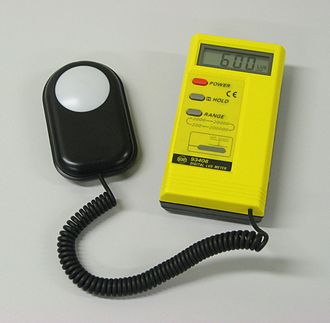Nilai Lux dan Cara Mengukur Intensitas Cahaya ?

Illuminance is a measure of how much luminous flux is spread over a given area. One can think of luminous flux (measured in lumens) as a measure of the total “amount” of visible light present, and the illuminance as a measure of the intensity of illumination on a surface. A given amount of light will illuminate a surface more dimly if it is spread over a larger area, so illuminance is inversely proportional to area when the luminous flux is held constant.
One lux is equal to one lumen per square metre:
1 lx = 1 lm/m2
A flux of 1000 lumens, spread uniformly over an area of 1 square metre, lights up that square metre with an illuminance of 1000 lux. However, the same 1000 lumens spread out over 10 square metres produces a dimmer illuminance of only 100 lux.
Here are some examples of the illuminance provided under various conditions:
| Illuminance (lux) | Surfaces illuminated by |
|---|---|
| 0.0001 | Moonless, overcast night sky |
| 0.002 | Moonless clear night sky with airglow |
| 0.05–0.3 | Full moon on a clear night |
| 3.4 | Dark limit of civil twilight under a clear sky |
| 20–50 | Public areas with dark surroundings |
| 50 | Family living room lights |
| 80 | Office building hallway/toilet lighting |
| 100 | Very dark overcast day |
| 150 | Train station platforms |
| 320–500 | Office lighting |
| 400 | Sunrise or sunset on a clear day |
| 1000 | Overcast day, typical TV studio lighting |
| 10,000–25,000 | Full daylight (not direct sun) |
| 32,000–100,000 | Direct sunlight |

A lux meter for measuring illuminance
The illuminance provided by a light source on a surface perpendicular to the direction to the source is a measure of the strength of that source as perceived from that location. For instance, a star of apparent magnitude 0 provides 2.08 microlux (μlx) at the Earth’s surface. A barely perceptible magnitude 6 star provides 8 nanolux (nlx). The unobscured Sun provides an illumination of up to 100 kilolux (klx) on the Earth’s surface, the exact value depending on time of year and atmospheric conditions. This direct normal illuminance is related to the solar illuminance constant Esc, equal to 128000 lux (see Sunlight and Solar constant).
The illuminance on a surface depends on how the surface is tilted with respect to the source. For example, a pocket flashlight aimed at a wall will produce a given level of illumination if aimed perpendicular to the wall, but if the flashlight is aimed at increasing angles to the perpendicular (maintaining the same distance), the illuminated spot becomes larger and so is less highly illuminated. When a surface is tilted at an angle to a source, the illumination provided on the surface is reduced because the tilted surface subtends a smaller solid angle from the source, and therefore it receives less light. For a point source, the illumination on the tilted surface is reduced by a factor equal to the cosine of the angle between a ray coming from the source and the normal to the surface. In practical lighting problems, given information on the way light is emitted from each source and the distance and geometry of the lighted area, a numerical calculation can be made of the illumination on a surface by adding the contributions of every point on every light source.

